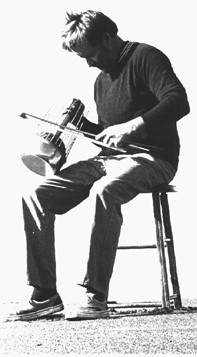
Richard Waters
US
Electronic, Rock and Jazz
A.k.a. Richard Adolphus Waters
Richard Waters (1935 – 2013) was an American artist, musician, and instrument designer, best known as an inventor of Waterphone. He grew up on the Mississippi Gulf Coast and studied painting at the University of Southern Mississippi, graduating in 1961. Waters received his M.F.A. in Painting and Drawing from the California College Of Arts And Crafts in 1965. As a guest lecturer, he had appeared at San Francisco State College, Sonoma State University, University of California, Berkeley, and Center For Music Experiment at UCSD. Since 1968, Richard Waters had performed with several ensembles, such as experimental/new music Gravity Adjusters Expansion Band, a jazz fusion group Listen, C-SIDE (California-Sonic Instrument Designers Ensemble), electroacoustic project Petit Mal, and SEAMS – Sonoma Electro Acoustic Music Society. He recorded two albums with Gravity Adjusters, produced World Seizure and Levitation cassettes with Petit Mal, and contributed a few compositions to Experimental Musical Instruments magazine/tape series. Waters also collaborated with Tom Waits on a few occasions: participated in Moanin' Parade and Swarm Warning free improv/experimental Gatmo Sessions with C-SIDE and Petit Mal, and appeared on his 3xCD Orphans: Brawlers, Bawlers & Bastards. Throughout his career, Richard A. Waters performed and recorded with numerous jazz musicians, free improvisers, and unconventional instruments builders/performers, including Mose Allison, John Abercrombie, Tom Beeson, Mel Martin, Bart Hopkin, Terry Bozzio, Bruce Cale, Lee Charlton, David Creamer, Fred Curchack, Chuck Day, Tom Dondelinger, Darrel De Vore, Dave Dunaway, Jon English, Mel Graves, Gary and Mike Knowlton, George Marsh, David Michalak, Wolfgang Melz, Andy Narell, Tom Nunn, Luis Peralta, Clyde Pound, and Bryce Rohde. Waterphone is a stainless steel/bronze acoustic tonal-friction instrument that utilizes water inside the resonators to bend tones and create water echos. The tonal rods are tuned to a combination of micro-tonal and diatonic relationships in two distinct scales with both even and uneven increments. Each Waterphone was unique and made to order, personally hand-assembled, tuned, signed and dated by Waters. In the mid-sixties, soon after graduating from the California College of Arts & Crafts, he stumbled across a unique instrument called Tibetan Water Drum – a round, slightly flattened bronze drum with an aperture in the center. The top surface was struck with a finger, slightly tilting the drum and moving a small amount of water inside, that created pre-echoes and tone bending. Another source of inspiration came from Kalimba, an African Thumb Piano, which deeply impressed Richard with an enormous amount of high-quality sound coming from such a tiny instrument. Waters was already working on a series of kinetic sculptures, some of which made sound, so he began making American Thumb Pianos – a tin can with bronze rods brazed to the rim, which acted as a primitive percussion. At the suggestion of jazz drummer Lee Charlton, Richard's friend, they tried putting a little water inside the 'Thumb Piano' reasonator, and then played the rods with well rosined bow. Waters improved the design and quickly decided to patent his invention. In 1969, he co-founded the Gravity Adjusters Expansion Band, where all members were playing various Richard's DIY instruments and other oddities, collected by Lee around the world, as well as utilized traditional instruments in very unconventional ways. A few guest musicians and local improvisers expressed great interest in Waterphone, and soon Shelly Manne and Emil Richards flew up from Los Angeles and attended Gravity Adjusters music sessions, each purchasing several Waterphones. Richards invited him to visit Los Angeles, where Waters sold his entire stock of instruments and sonic sculptures in a week, thus deciding to give up painting in favor of this new career path. The instrument is featured on many notable albums: Tutu, Soma by Steve Roach & Robert Rich, Three Worlds by Mel Graves, Marshland by George Marsh, Old Sugar Bear on Bill Frisell's Unspeakable, Todd Barton's Nosferatu, Droman, and Timbres, and Tan Dun's Water Music. Several musicians recorded an album solely on Waterphone, such as Waterphone and Xenophora: Music for Solo Waterphone. Waterphones were also used on film and TV soundtracks, including Poltergeist (Original Motion Picture Soundtrack) and Star Treks by Jerry Goldsmith, A Pure Formality and Bugsy (Original Motion Picture Soundtrack) by Ennio Morricone, Young Guns Original Motion Picture Score, Invasion of the Body Snatchers remake, Powder, Mystery Men, The Matrix, The Shadow Conspiracy, Crouching Tiger, Hidden Dragon, and many others. A few Waterphone collectors and performers: Aerosmith, Kim Atkinson, Richard Barone, Carson Cooman, Rubem Dantas, David Darling, Karen Elaine, Reinhard Flatischler, Evelyn Glennie, Dave Grusin, Sofia Gubaidulina, Imogen Heap, Toshiyuki Hiraoka, Kitaro, Klang, Peter Lockett, Robert Minden Ensemble, Not Breathing, Christopher Rouse, Lalo Schifrin, Tom Scott, Bertram Turetzky, Glen Velez, and many others.
Genres
Plays With
| Gravity Adjusters Expansion Band |
Band Members
ArtistInfo App
ArtistInfo for iOS and ArtistInfo for Mac are presenting musicians, composers and producers that are envolved in the musical work that you are listening to in Apple Music, iTunes, or Spotify. Discover new music via the network among artists. Manage your favorite musicians and albums via iCloud and share recommendations with your friends via email, AirDrop, or Social Media.Acknowledgements
To all the music fans that are contributing on Discogs, MusicBrainz and Wikipedia. Thanks to Franz Flückiger for providing Storygram used to visualize band membership.Other Search Results
| Richard Waters |
| Richard Waters dr |
| Richard Waters vl Classical |
| Richard Waters US |
| Richard Waters Classical |